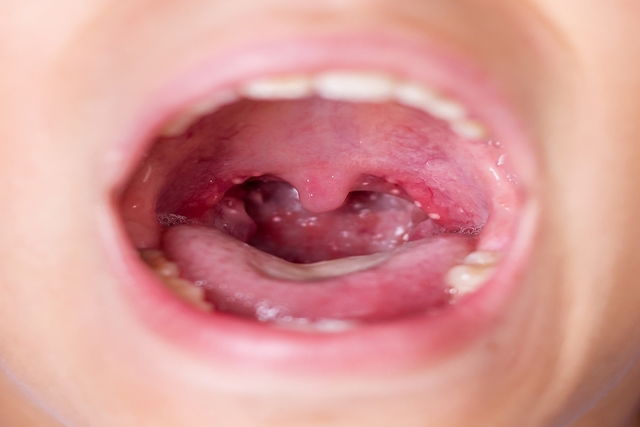Herpangina is a disease caused by Coxsackie viruses, enteroviruses or herpes simplex viruses that affects babies and children between the ages of 3 and 10. It is associated with symptoms such as sudden fever, mouth sores and sore throat.
Herpangina symptoms can last for up to 12 days. There is no specific treatment for this condition, and treatment involves symptoms management to aid recovery.
Herpangina is normally a mild condition that lasts for a few days, but in rare cases some children may present complications such as abnormalties in the nervous system and heart or lung failure. Therefore, if you suspect herpangina, you should see a pediatrician for assessment and treatment.

Main symptoms
The main symptoms of herpangina are:
- Blisters in the mouth and throat, which can burst and leave whitish spots
- Sudden fever, which usually lasts 3 days
- Sore throat
- Red and irritated throat
- Small white wounds inside the mouth with a reddish circle around it. The child may have 2 to 12 small canker sores inside the mouth, measuring less than 5mm each
- Canker sores are usually found on the roof of the mouth, tongue, throat, uvula and tonsils, and can remain in the mouth for 1 week
- Bumps may appear in the neck region
Symptoms can appear between 4 and 14 days after initial contact with the virus. It is not uncommon for a child to present symptoms about 1 week after being in a waiting room with other sick children waiting for an appointment or in crowded places with poor conditions.
Confirming a diagnosis
A herpangina diagnosis is made through an evaluation of symptoms, but the doctor may request further tests to confirm the disease and to identify the underlying virus that led to this condition.
In the presence of confirmed herpangina outbreaks, in school settings, for example, the doctor may opt not to order further tests.
How it's transmitted
Transmission of the virus responsible for herpangina can happen when the child comes into contact with the cough or sneeze secretions of an infected person. However, the virus can also be found in feces and, therefore, dirty diapers and clothes can also lead to herpangina transmission.
Herpangina is easily transmitted disease, and babies and children who attend nurseries and daycare centers are most at risk due to frequent contact.
Treatment options
Treatment for herpangina involves relieving symptoms. It does not require the need for specific antiviral medications. The pediatrician may recommend treatment at home with the use of antipyretic medication, such as acetaminophen, to relieve fevers. Anti-inflammatories and topical anesthetics can be prescribed in children over 2 years of age.
Also recommended: 10 Home Remedies for Sore Throat: Grapefruit, Mint & More tuasaude.com/en/sore-throat-home-remediesDiet recommendations
The sores in the mouth can make chewing and swallowing painful, and therefore you should opt for a liquid and soft diet that is low in salt. You can consume non-citrus juices, soups and purees, for example. Greek yogurt is another good option for keeping the baby fed and hydrated, particularly because cold foods may offer more relief.
You should also offer the child plenty of water so that they can recover faster. Lots of rest is also recommended, and you should avoid overstimulating the child so that they can rest and sleep adequately.
Learn more about what to eat with a sore throat.
Signs of improvement or worsening
Signs of improvement include a reduced fever within 3 days, an improvement in appetite and a decrease in throat soreness.
However, if this does not happen or if other symptoms emerge, such as febrile seizures, you should return to your pediatrician for re-assessment. Although it is rare, complications such as meningitis may arise. Worsening conditions are likely to be treated in a hospital setting.
Preventing transmission
Washing your hands frequently and always after changing your child's diaper or clothes when soiled is a simple measure that can help prevent the spread of this disease to other children. Using an alcohol gel solution after changing a diaper is not enough and should not replace washing your hands properly.
